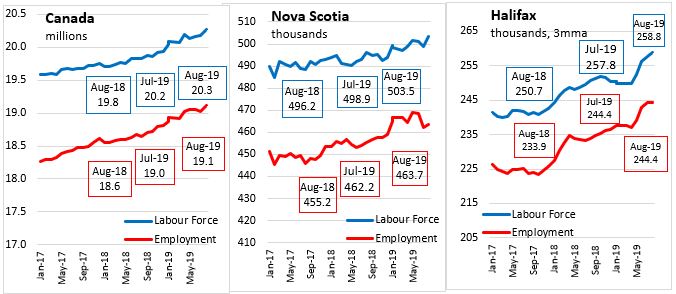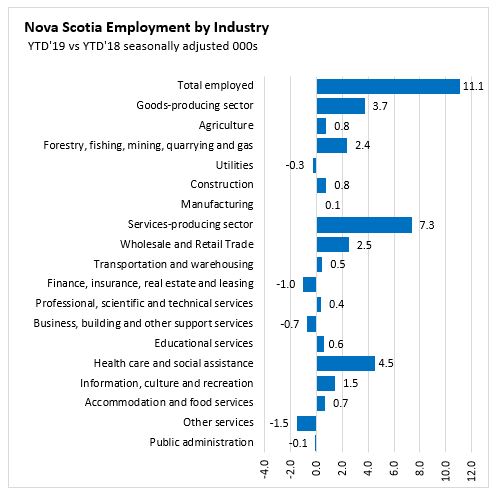NS Construction up 800 jobs in the first 8 months of 2019
STATS CAN – Labour Force Survey – August 2019
*Information and raw data provided by Statistics Canada*
“While employment was little changed in all other provinces in August, the unemployment rate increased in both British Columbia and Nova Scotia. The unemployment rate rose 0.6 percentage points to 5.0% in British Columbia and 0.5 percentage points to 7.9% in Nova Scotia as more people searched for work in each province.” – Statistics Canada
In Nova Scotia August 2019, (seasonally adjusted, month-over-month and year-over-year):
- Labour force increased 0.9 per cent (4,600) from July 2019 to 503,500 and increased 1.5 per cent (7,300) over August 2018
- Employment increased 0.3 per cent (1,500) from July 2019 to 463,700 and increased 1.9 per cent (8,500) over August 2018
- Unemployment increased 8.4 per cent (3,100) from July 2019 to 39,800 and decreased 2.9 per cent (1,200) over August 2018
- Unemployment Rate increased 0.5 percentage points from July 2019 to 7.9 per cent.
In Canada August 2019, (seasonally adjusted, month-over-month and year-over-year):
- Labour force increased 0.5 per cent (91,300) from July 2019 to 20,271,600 and increased 2.2 per cent (443,800) over August 2018
- Employment increased 0.4 per cent (81,100) from July 2019 to 19,111,500 and increased 2.5 per cent (471,300) over August 2018
- Unemployment increased 0.9 per cent (10,200) from July 2019 to 1,160,100 and decreased 2.3 per cent (27,600) over August 2018
- Unemployment Rate remains virtually unchanged from July 2019 at 5.7 per cent.
In Halifax August 2019, (seasonally adjusted, three-month moving average, month-over-month and year-over-year):
- Labour force increased 0.4 per cent (1,000) from July 2019 to 258,800 and increased 3.2 per cent (8,100) over August 2018
- Employment remains virtually unchanged from July 2019 at 244,400 and increased 4.5 per cent (10,500) over August 2018
- Unemployment increased 7.5 per cent (1,000) from July 2019 to 14,400 and decreased 14.3 per cent (2,400) over August 2018
- Unemployment Rate increased 0.4 percentage points from July 2019 to 5.6 per cent
Labour Market Trends – August 2019
Nova Scotia’s seasonally adjusted employment level was up 1,500 in August to 463,700. Employment is 8,500 higher than it was last August.
Nova Scotia’s employment increase follows the previous month decrease of 6,200. Compared to July, Nova Scotia’s labour force was increased by 4,600 rising to 503,500 in August. With a larger increase in labour force than employment, the number of employed was up by 3,100 persons. The unemployment rate was up 0.5 percentage points to 7.9 per cent in August.
In August, full-time employment decreased by 400 while part-time employment was up 2,000 persons. Note: Changes in part-time and full-time employment can include the net impacts of changing hours of work within the same position.
Monthly employment gains in August reflected a rise in private sector employment (+4,800), partially offset by declines in public sector work (-2,000) and self-employment (-1,300). Monthly employment in August was up 2,600 in goods industries and down 1,000 in service sectors.
The year-over-year increase in employment includes a decline of 300 in full-time employment and an increase of 8,900 in part time employment. The unemployment rate was down 0.4 percentage points compared to August 2018.
Comparing the first eight months of 2019 with the same months in 2018, the labour force grew by 7,200 (1.5%) while employment was up by 11,100 (2.4%). This pushed the year-to-date average unemployment rate down from 7.7 per cent in Jan-Aug 2018 to 6.9 per cent in Jan-Aug 2019.
Sectors – Year to Date
Looking at the results by class of worker for the first eight months of 2019, employment increased for the private sector (10,400) and for the public sector (4,200) more than outweighed the decline in self-employment (-3,600). Over the first eight months of 2019, Nova Scotia averaged 292,300 private sector employees, 115,900 public sector employees, and 57,500 in self-employment.
Among goods-producing sectors, the first eight months of 2019, saw employment increases in Forestry, fishing, mining, quarrying, oil and gas (+2,400) as well as Construction (+800) and Agriculture (+800). Manufacturing employment was mostly unchanged (+100) while utilities employment declined (-300).
Services-producing industries averaged 7,300 more jobs compared to the first eight months of 2018. The largest increases come from Health care and social assistance (+4,500), Wholesale/Retail Trade (+2,500), as well as Information, culture and recreation (+1,500). The largest declines came from Other services (-1,500 mostly personal/repair sectors), Finance, insurance, real estate and leasing (-1,000), and Business, building and other support services (-700).


